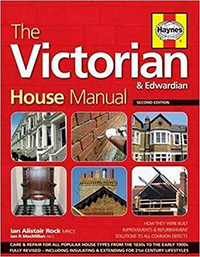
Knowing how to fix guttering and drainpipes is a must for any homeowner. The structural health of your home depends on it – rain needs to be channeled away from a building safely and correctly via well kept house gutters; otherwise, it will saturate solid walls, which will in turn lead to timber decay and beetle infestation.
Worse, when the ground next to the house is allowed to become consistently wet and marshy it can eventually undermine shallow foundations. It is therefore important to know how to spot faults in guttering and downpipes.
Bought a home and need advice on more than how to repair cast iron guttering? Find out more in our ultimate guide to house renovation.
This feature is an edited extract from the Victorian & Edwardian House Manual by Ian Rock, published by Haynes. Ian Rock is a chartered surveyor and director of survey price comparison website rightsurvey.co.uk
How to tell if guttering is broken
What to look for in damaged house gutters:
- Damp patches on walls or ceilings, but bear in mind that moisture can travel in unexpected directions so the cause may not be obvious. Follow our advice on how to deal with damp and rot.
- Stains, discolouration and moss on walls, and plant growth in and around rainwater goods.
- Deterioration to masonry due to frost damage, caused by the wall becoming saturated with water.
- Water collecting around the base of the building.
- Gutter bolts or other fixings or pieces found on the ground near to the house.
How to check your guttering for damage
It is easy to assess the state of rainwater goods and undertake regular maintenance to ensure they work efficiently. This review is best carried out at least once a year, especially in autumn when the trees have shed their leaves.
To judge whether your guttering system is fit for purpose, start at the top of your property and visually follow the route the rainwater takes down to the ground, or on rainy days check for leaks and overflows. To prevent rainwater cascading off roofs, it’s important that the guttering is positioned correctly, and that there are sufficient downpipes to cope with a heavy downpour – at least one downpipe for every 10 metres of wall.

Common faults and defects in guttering
With house gutters, it is essential that the brackets and fixings that attach the guttering to exterior walls are secure and able to withstand heavy seasonal loadings from snow and ice. The general rule is one bracket per metre length of guttering, with support more closely spaced at junctions, such as corners to bay roofs.
Guttering is supposed to slope down, or ‘fall’, slightly towards the downpipe. If there is no significant slope, the water will not flow away and a build-up of sediment may cause overflowing. Too steep, however, and torrents of water will gush past and overshoot. One traditional method that allowed adjustment in situ was the use of special metal ‘rise & fall’ brackets to achieve the correct fall.
Many Georgian and early Victorian townhouses have gutters hidden behind front parapet walls or balustrades at the top of the main walls – the most challenging of all. Some even have secret internal gutters and downpipes running under floors. Being out of sight from street level these tend to be ignored until a serious leak develops. Although replacing a lead lining need not be too difficult, the condition of the timber plate supporting it may not be apparent until the covering is removed – and replacing this can seriously add to the cost.
For more advice on jobs you need to do to maintain older properties see our period home maintenance calendar
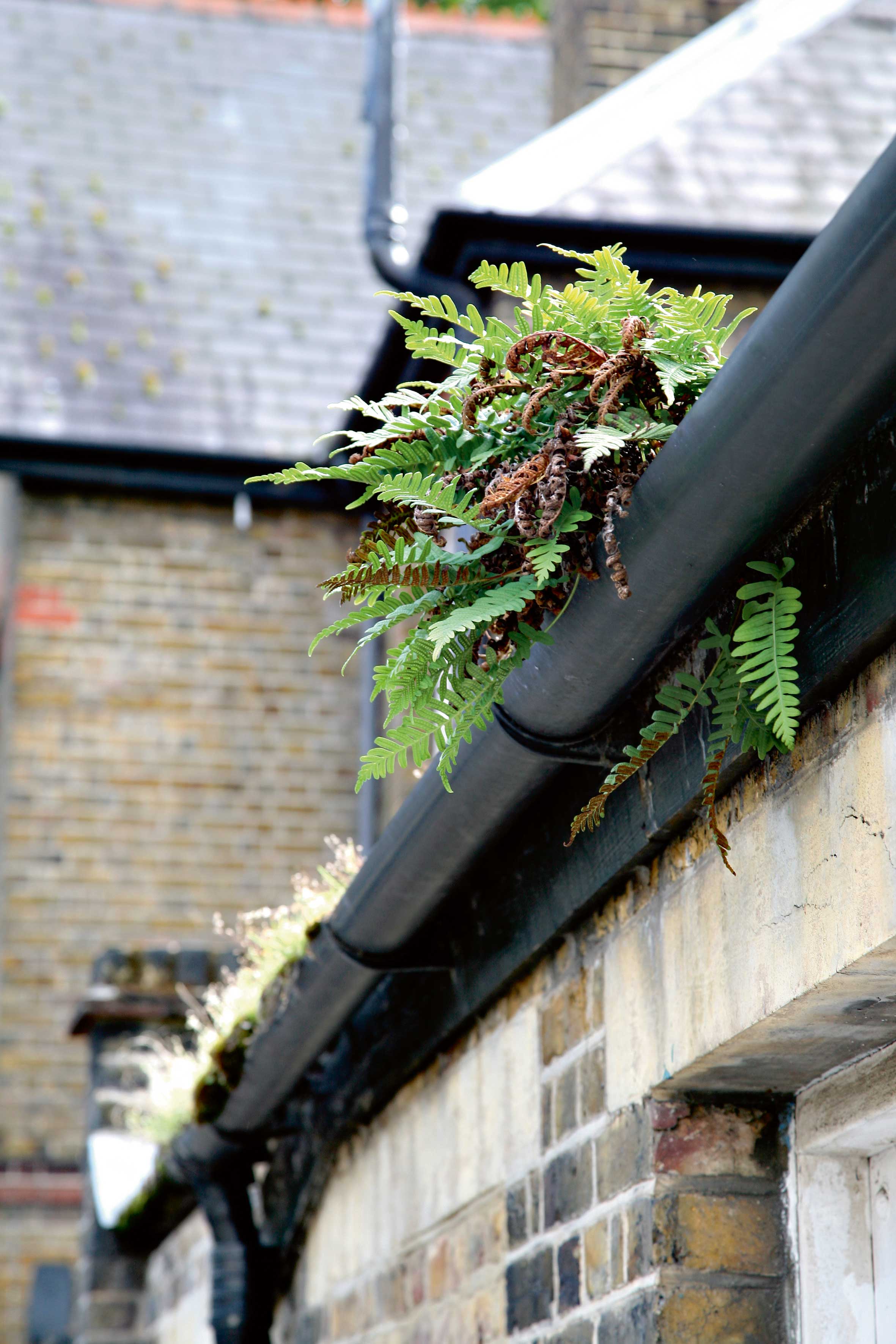
How to fix guttering
These are the common defects you'll find in house gutters and that you'll need to tackle.
Blocked gutters or downpipes
Gutters and downpipes that are blocked by leaves, moss and other debris cause water to spill down the face of the wall or seep into the timber behind the gutter, including the ends of rafters and joists. Water trapped in pipes during cold weather can freeze, resulting in cracks and splits in the metalwork.
- Wearing gloves, clear out leaves and other debris and check the system thoroughly.
- If necessary, gently feed a garden hose along pipes to flush them through.
- Maintenance is made easier by fitting gutter guards that reduce the risk of leaves causing blockages. A variety of versions are available, including mesh strips that clip over gutters, and brushes that lie inside.
- Install pipe balloons to prevent debris from entering downpipes.
Cracked gutters and downpipes
The source of water seepage from downpipes and guttering is not always obvious, so check the back, if necessary using a mirror. Often these areas are difficult to paint, resulting in cast iron rusting.
- Replace the section of pipe or gutter.
- Temporary repairs can sometimes be made with joint repair tape or gutter sealant.
- Repairs to lead downpipes should be made by a specialist leadworker

Joints and loose pipes
Joints are a potential weak point in both gutters and downpipes, so ensure they haven’t become disconnected and are leak free. Rusted or missing bolts are often the culprit, along with loose gutter brackets and downpipe fittings.
- Secure or replace all missing, loose or rusted gutter fixings.
- Seal joints with gutter sealant.
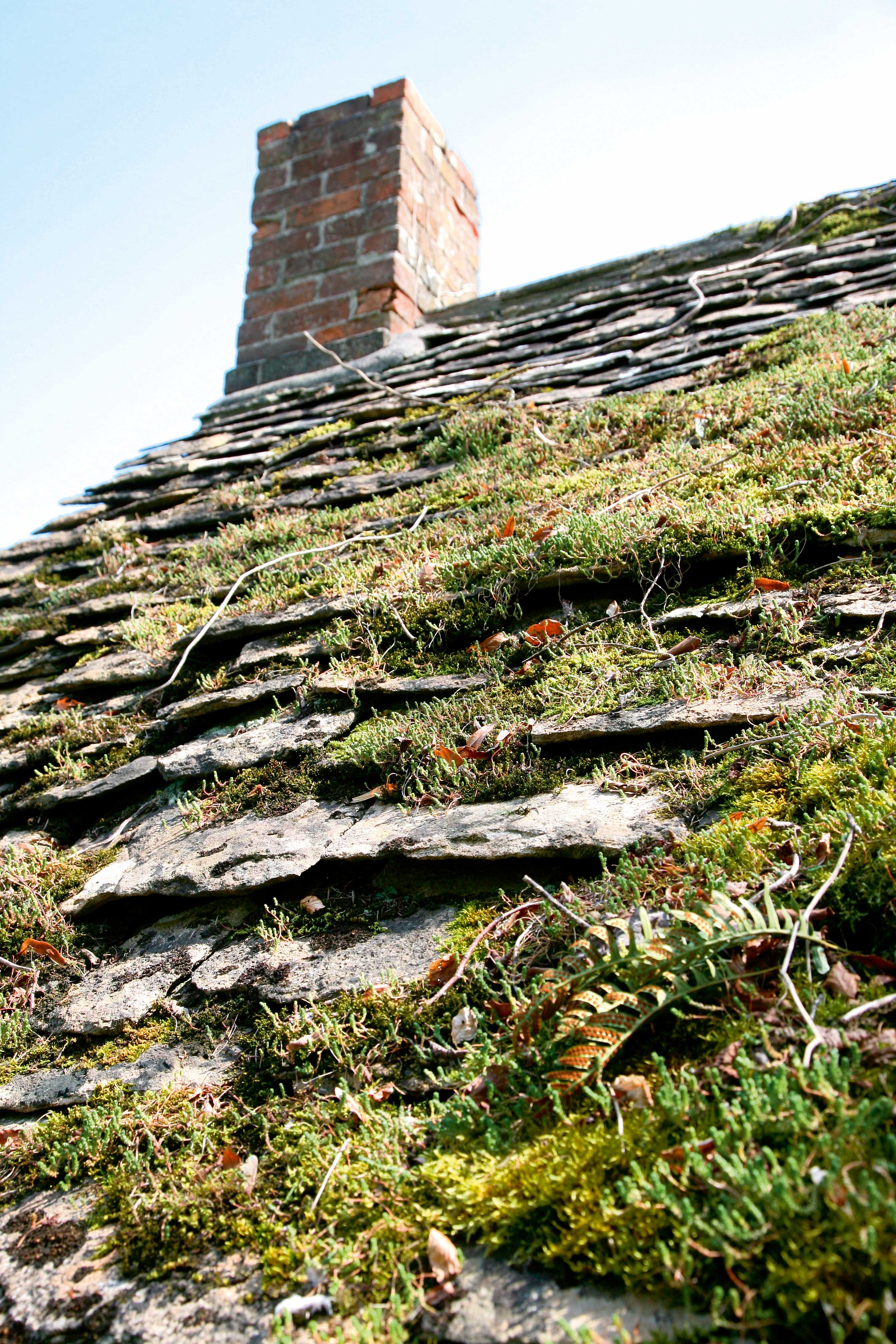
Insufficient fall
Where a gutter is clear but water is not running away, the ‘fall’ or angle may be incorrect. A good way to test this is by pouring a bucket of water along the gutter. If the slope is insufficient the water will not flow away, whereas if it’s too steep water will overshoot the house gutters.
- Refix or replace gutter brackets that are loose, missing or causing the gutter to sag.
- Realign the gutter to increase the fall.
- Ensure gutter brackets are fixed to a sound surface and are capable of supporting the added weight of snow or heavy downpours – ideally one bracket per every metre length of gutter.
Drainage
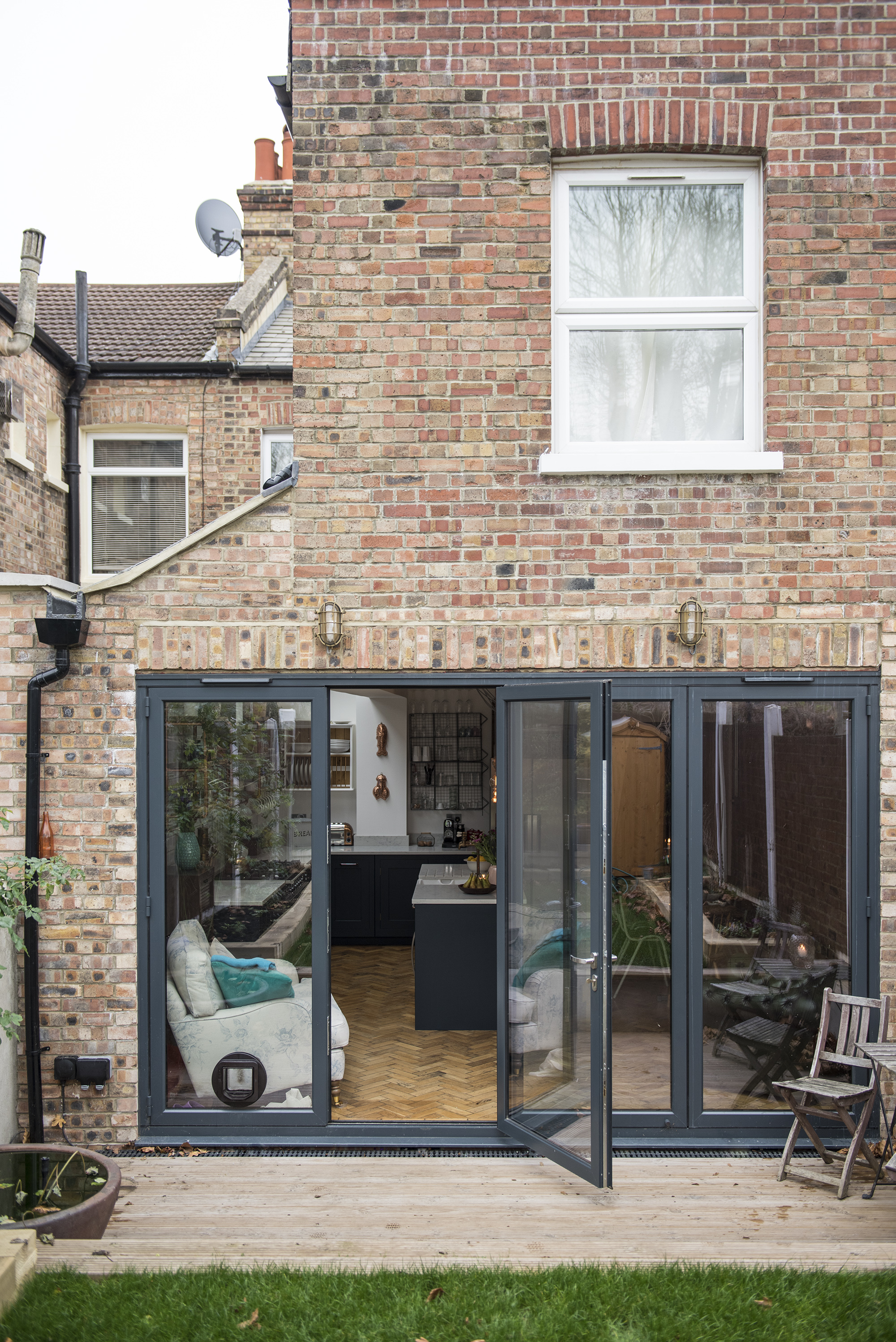
A rainwater system should empty into gullies and drains at the base of downpipes so the water flows clear of the building. An easy way to check the guttering system is running freely is by tipping a bucket of water down it.
- Wearing gloves, clear any debris from gullies or, if necessary and possible, use drain rods.
- Protect gullies with easily removable grille covers, which are available in a range of styles.
- Fit a ‘shoe’ at the base of a downpipe to direct water away from the wall and into a drain.
- Improve inadequate drainage.
Maintaining guttering
Cast-iron downpipes and hoppers were traditionally fixed to walls with iron spikes driven into the wall through pairs of cast-iron ‘ears’. Because they are positioned close to the wall this makes decoration difficult, leaving the backs vulnerable to rust. When replacing them it is therefore a good idea to add spacers so they are about a finger’s width out from the wall.
Downpipes normally discharge into a gulley in the ground, which leads to the underground drainage system. Gulleys intercept debris and block smells, rather like traps under sinks. Where downpipes terminate above the gulley, a ‘shoe’ is normally fitted to the bottom of the pipe to help slow and direct the flow.
When they are open in this way, rather than directly connected into the underground drainage system, the downpipes can be inspected and maintained easily, but then leaves and rubbish can accumulate causing blockages, so it is advisable to fit a grille covering over the gulley.
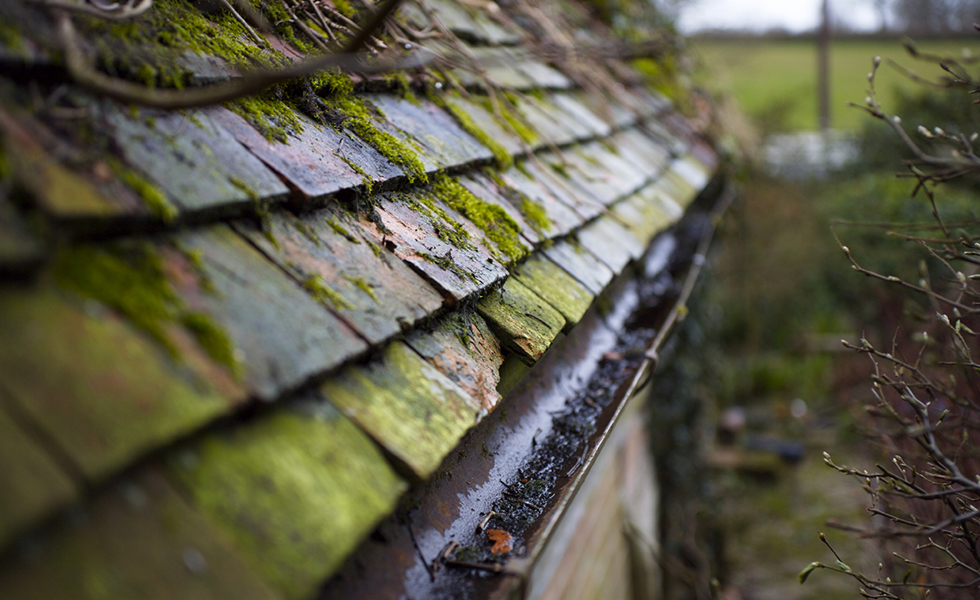
Guttering materials
Victorian guttering and downpipes were mostly made of cast iron, which superseded earlier Georgian lead-lined timber box gutters. However, on grander properties lead continued to be used for hoppers – ‘collection boxes’ located at the tops of downpipes – often bearing decorative embossed emblems.
Towards the end of the 19th century there was a short-lived vogue for copper guttering among Arts and Crafts architects, but as an expensive material its use was restricted to the best quality housing.
In recent years the rainwater fittings on many period houses have been thoughtlessly replaced with cheap-looking plastic gutters, often poorly fitted in clashing styles and colours. Only where buildings are listed or located in Conservation Areas is it likely that homeowners will have replaced the old guttering in authentic matching materials.
Cast iron
If your house still has its original cast-iron guttering and rainwater fittings, the best option is to overhaul the existing system. Where replacement is necessary, new factory-painted cast-iron systems are widely available, either curved ‘half-round’ style or wavy-fronted ‘ogee’ – the latter fixed directly to fascia boards rather than using brackets.
Cast iron looks authentic, plus its strength makes it resistant to damage, such as from ladders leant against it. It does, however, weigh a lot, and requires periodic decoration to prevent deterioration through rust. Although dearer than standard plastic fittings from DIY stores, cast-iron fittings have greater longevity, so work out cheaper in the long term.
Aluminium
The next preferred option for period homes is cast aluminium, which looks very similar to traditional cast iron. Although not the cheapest, aluminium is highly durable and also rust proof, so therefore low maintenance, and is considerably lighter than cast iron.
Replacement fittings can be ordered with a powder-coated finish, saving the cost and inconvenience of painting at height. Aluminium guttering is also available in a thinner continuous ‘extruded’ version, which is roll-formed on site, but looks less authentic.
Plastic
PVC guttering is the cheapest option and also relatively light, making installation easier and quicker. Although it doesn’t suffer from corrosion, plastic is very prone to developing leaks at joints due to expansion and contraction, and older fittings become brittle with age and degrade in sunlight.
It is also a fairly flimsy material and prone to damage. Unlike cast iron, plastic has an unfortunate tendency over time to sag between brackets, which can then affect the alignment, causing discharge problems.
There are two main styles – curved ‘half-round’, and ‘squareline’, both available in a variety of colours. Plastic rarely looks complementary on old buildings. Traditional designs are, however, now available in glass-reinforced polyester, which replicates the texture and style of cast-iron fittings, but has a shorter lifespan.
Repairing cast-iron guttering and downpipes
Keeping cast-iron guttering and downpipes in good condition requires periodic maintenance. Small leaks and loose pipes can usually be repaired fairly easily, but major restoration work is a specialist job because of the need for working at height and manoeuvring awkward lengths of heavy guttering.
- Where old joints are still sound they can be painted over, but where rust has set in, joints need to be dismantled, stripped and painted before being re-joined using a suitable silicone mastic. Weak spots at risk of corrosion can be found in any areas that evaded regular painting – such as the backs of downpipes and around brackets.
- Any rusted areas need to be exposed by stripping back to bare metal. The presence of old lead paint means that chemical strippers are safer than power-sanding. Any sound paint is best left and lightly rubbed down by hand, taking safety precautions, to provide a key.
- Rust can be chemically neutralised with anti-corrosive gels even in house gutters. Bare metal can be primed with two coats of zinc-based protective metal primer, which provides chemical protection against future rust. This is followed by two further coats of special iron oxide paint to give a protective finish, not forgetting the inside surfaces of the gutters.
- Finally, visible areas can be given a top decorative coat. Where, however, downpipes are partially built into walls or embedded in render, the surfaces in contact with walls are impossible to paint, so eventually they will rust and leak causing damp problems. Removal is likely to cause damage, so a good option is to leave the original feature in place and fit a new matching downpipe nearby to take on the job of dispersing rainwater.
Connecting to the drainage system
Victorian downpipes were sometimes left unconnected at the bottom, squirting out water into puddles next to damp walls, with soft ground threatening the stability of shallow footings. It is important that water is channelled well away from the walls. Also, in rows of terraces with small front gardens it was common for downpipes to discharge out to kerbs in pavements. As long as the pipes are free from leaks, this time honoured arrangement should still be acceptable.
With new pipework, it is not usually permitted to connect rainwater – referred to as ‘surface water’ or ‘storm water’ – to the main foul drainage system serving bathrooms and kitchens, to avoid overloading public sewers with water that does not need treatment.
Historically, however, Victorian houses in urban areas used ‘combined systems’, so in some cases it may still be acceptable for rainwater to discharge into the sewer system. One clue to this is where you can see that original bathroom waste pipes discharge into the same hopper or gulley that takes the rainwater from the gutter.
Words Ian Rock and Roger Hunt

Why spring is the most important time to fix gutters
Hear of April showers? If you haven't already been doing it throughout the winter months, early spring is the time to clear your guttering of leaves and debris that would've inevitably accumulated since the autumn clean. Moreover, you may find an abandoned bird's nest that's blocking your gutter. If you find any active bird or squirrel nests in your gutters, the best course of action is to phone up the environmental health department of your council or RSPCA.
More home maintenance advice:
- Garden maintenance checklist
- How to deal with subsidence and structural movement
- How to repair an old roof
The Victorian House Manual | RRP £17.50 on Amazon
Want to take better care of your period home? This Haynes Manual by Ian Rock is the essential read for any owner of a Victorian (or Edwardian home).
Join our newsletter
Get small space home decor ideas, celeb inspiration, DIY tips and more, straight to your inbox!
Ian Rock MRICS is the chartered surveyor author of eight Haynes Property Manuals, and is the director of the RICS home survey price comparison website Rightsurvey.co.uk
-
 This colourful home makeover has space for kitchen discos
This colourful home makeover has space for kitchen discosWhile the front of Leila and Joe's home features dark and moody chill-out spaces, the rest is light and bright and made for socialising
By Karen Wilson Published
-
 How to paint a door and refresh your home instantly
How to paint a door and refresh your home instantlyPainting doors is easy with our expert advice. This is how to get professional results on front and internal doors.
By Claire Douglas Published
-
 DIY transforms 1930s house into dream home
DIY transforms 1930s house into dream homeWith several renovations behind them, Mary and Paul had creative expertise to draw on when it came to transforming their 1930s house
By Alison Jones Published
-
 12 easy ways to add curb appeal on a budget with DIY
12 easy ways to add curb appeal on a budget with DIYYou can give your home curb appeal at low cost. These are the DIY ways to boost its style
By Lucy Searle Published
-
 5 invaluable design learnings from a festive Edwardian house renovation
5 invaluable design learnings from a festive Edwardian house renovationIf you're renovating a period property, here are 5 design tips we've picked up from this festive Edwardian renovation
By Ellen Finch Published
-
 Real home: Glazed side extension creates the perfect garden link
Real home: Glazed side extension creates the perfect garden linkLouise Potter and husband Sean's extension has transformed their Victorian house, now a showcase for their collection of art, vintage finds and Scandinavian pieces
By Laurie Davidson Published
-
 I tried this genius wallpaper hack, and it was perfect for my commitment issues
I tried this genius wallpaper hack, and it was perfect for my commitment issuesBeware: once you try this wallpaper hack, you'll never look back.
By Brittany Romano Published
-
 Drew Barrymore's new FLOWER Home paint collection wants to give your walls a makeover
Drew Barrymore's new FLOWER Home paint collection wants to give your walls a makeoverDrew Barrymore FLOWER drops 27 brand-new paint shades, and every can is made from 100% post-consumer recycled plastic.
By Brittany Romano Published

